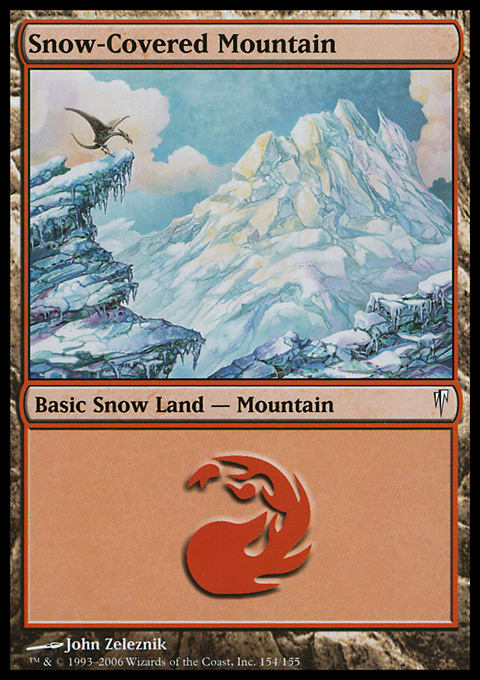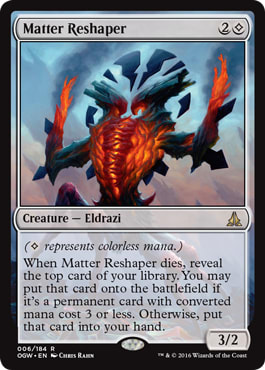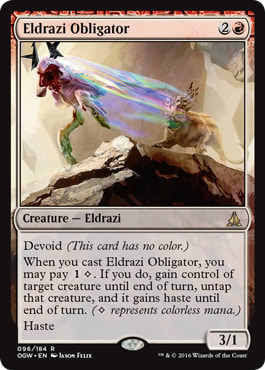In this article, I'm going to discuss the impact that Oath of the Gatewatch will have on Cubes, starting with its colorless cards.
Since the set's colorless cards and cards like Eldrazi Displacer require colorless mana to cast, we'll first want to talk about how to reasonably accommodate them.
Looking at the average four-hundred-fifty-card Cube on CubeTutor pre-OGW, there are only fourteen sources of colorless mana.
- Everflowing Chalice
- Mana Vault
- Sol Ring
- Grim Monolith
- Mind Stone
- Basalt Monolith
- Worn Powerstone
- Thran Dynamo
- Ancient Tomb
- Mutavault
- Mishra's Factory
- Strip Mine
- Volrath's Stronghold
- Wasteland
Think of how many sources you'd need to splash for a color in a Cube deck—like splashing for a Sphinx's Revelation in an Izzet control deck. From the Cube Tutor four-hundred-fifty-card average, there are slightly more: eighteen.
- Mox Diamond
- Boros Signet
- Izzet Signet
- Chromatic Lantern
- Coalition Relic
- Gilded Lotus
- Mana Confluence
- City of Brass
- Plateau
- Volcanic Island
- Sulfur Falls
- Clifftop Retreat
- Sacred Foundry
- Steam Vents
- Terramorphic Expanse
- Evolving Wilds
- Arid Mesa
- Scalding Tarn
That said, this doesn't mean these are equivalent—putting a Plateau or a Clifftop Retreat in a W/U control deck doesn't hurt you that much (tempo loss and unreliability aside) since they can still reliably help cast the other twenty-two spells in your deck, whereas a Mishra's Factory used to splash for a Thought-Knot Seer may not.
This makes including cards like Thought-Knot Seer and Reality Smasher need some additional help. Thankfully, since a Cube is a customizable format, we can address that in a few ways.
1 — Add Wastes to Your Basic Lands
About ten years ago, it was common to see basic lands counted as snow-covered so that cards like Skred, Mouth of Ronom, Phyrexian Ironfoot, and Scrying Sheets could emulate how they played in Constructed. This was a compromise, as it didn't emulate how they were in Coldsnap Limited, where snow basics were in the packs themselves. Doing that in Cube would mean a lot of wasted cards—snow basics wouldn't be worth the picks, and snow-matters cards would have been unsupported.
You don't tend to see this nowadays, as lands and colorless cards became better, and it wasn't really worth using snow basics just for Skred. However, the payoff for OGW colorless cards in Cube is much higher, and we can use that same lesson for Cube nowadays by allowing drafters to include Wastes with the basic lands.
These basic land-searching cards in the Cube Tutor average four hundred fifty can now find Wastes if they're included with basic lands:
- Sakura-Tribe Elder
- Cultivate
- Kodama's Reach
- Rampant Growth
- Yavimaya Elder
- Path to Exile
- Solemn Simulacrum
- Evolving Wilds
- Terramorphic Expanse
2 — Include More Colorless-Mana Sources
Early in Cubes, sections were all the same size: fifty of each color, artifacts, and lands, with sixty in multicolored and white, red, and black having even creature and noncreature ratios. These rigid sections were partially a self-disciplining measure to make sure people weren't skimping on creatures or overloading on multicolored, but this rigidity is no longer needed, as sections can be elastic, a topic I discussed in my “Cube Expansion Pack” article.
There's a temptation that, since there are some great colorless-only-producing mana rocks, you may not be running to overload on them for your Cube. Some colorless cards, like Kozilek, the Great Distortion, aren't going to be played in aggressive decks anyway, but as others like Matter Reshaper and Thought-Knot Seer will be, it's important to maintain balance for aggressive and nonaggressive elements in your Cube, so make sure you're including ones for aggro decks, too, such as Blinkmoth Nexus and Tectonic Edge.
I used to run a “wildcard” cycle of lands before this set:
Ally colors — Celestial Colonnade, Creeping Tar Pit, Raging Ravine, Lavaclaw Reaches, Horizon Canopy
Enemy colors — Battlefield Forge, Cascade Bluffs, Llanowar Wastes, Fetid Heath, Yavimaya Coast
This helped grant the enemy-color pairs that valued early drops (aggro with Battlefield Forge, green enemy pairs for mana Elves) earlier access to mana, while others with more intensive requirements gained filters, but this was customizable, and you can do the same with your mana-fixing. There also a thread on MTGSalvation that does the heavy lifting by listing colorless-producing cards for other options.
The Colorless-Cost Cards
Kozilek, the Great Distortion is the big payoff colorless card. Like other legendary Eldrazi, it's not uncommon to have this enter play via cheating it into play either with Show and Tell, Eureka, or reanimation, but its cast trigger is absurdly powerful and draws more cards than you'd think in an archetype like green-based ramp that ramps into big-business spells quickly, making their hands small in the process. It does suffer from the weakness of not being able to pull you back from behind like either Ulamog, the Infinite Gyre or Emrakul, the Aeons Torn can, but it's great when on parity or to close out the game since it can protect itself very well with its discard ability. Because of this, it's a good card to include to supplement high-end threats while being a decently evasive one on its own.
Endbringer has the potential to do a lot through its activated abilities—as cliché as it is, it doesn't pass the vindicate test very well, which is a hard sell for a 6-mana finisher. If it untaps, especially if cast early, it's absurd and can take over the game quickly by dealing a ton of damage and gaining card advantage since decks that can reliably cast it typically can at least draw a card, if not several. However, it may be a hard sell for smaller Cubes since it's relatively fragile.
Reality Smasher is a riff on Thundermaw Hellkite as a big, dumb, hasty, tramply attacker as a midrange threat, Wildfire survivor, or aggro curve-topper, and because it hits so hard and fast, it's worth the payoff for using colorless mana. Since most spot removal that could hit it tends to be spell-based (not effect-based), if it dies to a Doom Blade, it at least takes another card with it, which does help to act as removal protection. It's arguable that a card like Thundermaw Hellkite may be better, but other colors don't have access to big, hasty threats, making it a welcome addition.
Matter Reshaper was compared to Kitchen Finks, and while it isn't quite as good in midrange and control as Kitchen Finks is—since it is reliant on dying to go along with those decks' game plans (gaining value through card advantage)—which did it naturally through gaining life, it's still a good card for those decks since it generates great value and pressures Planeswalkers and players well. It's more at home in aggressive decks since it pressures so well, making it a great colorless threat.
Thought-Knot Seer didn't receive quite the love it initially deserved since it was initially compared to cards like Mesmeric Fiend, which don't let the opponent draw a card when it dies, but Thought-Knot Seer instead gets rid of the card for good while being a very good onboard threat, something cards like Mesmeric Fiend, Brain Maggot, and, arguably, Tidehollow Sculler couldn't say (Vendilion Clique is, of course, absurd). It's true that if Thought-Knot Seer reveals a hand of mostly weak cards and the opponent kills it, he or she is up a card, but this really isn't that bad for a worst-case scenario, as the opponent had to top-deck a removal card. For the most part, these kinds of cards are disruption first and creatures second, and Thought-Knot Seer's 4/4 body lets it play the creature part better than most of its predecessors, making this a great capstone to colorless threats.
The Colorless-Ability Cards
Sea Gate Wreckage and Mirrorpool work toward opposite ends of the spectrum by tacking spell effects onto lands. Both of these work with the strengths of opposite decks (aggro–control), and although Mirrorpool only lets you Clone your own things, it can help to gain extra oomph out of direct damage and counterspells in counter fights, and being able to copy your own value creatures at end of turn or in response to a removal spell is a very nice bonus. Mirrorpool's individual modes are pretty pricey, and it enters the battlefield tapped, but they're stapled onto a land, which we've learned through cards like Volrath's Stronghold can be great even if they're a bit overpriced—because they didn't cost a spell slot.
Eldrazi Displacer has decent base stats as a 3/3 for 3, but it becomes a value machine once you make colorless mana. It's reminiscent of cards like Mistmeadow Witch and Crystal Shard, which work more on an effectiveness axis than efficiency; even if ![]() {C} to Flicker something is expensive, it's on a decent body that can attack while performing that goal and even protects your own threats or taps blockers. It's a rough sell in control decks with few creatures, but most other white decks, provided that they have the colorless sources, use Eldrazi Displacer well.
{C} to Flicker something is expensive, it's on a decent body that can attack while performing that goal and even protects your own threats or taps blockers. It's a rough sell in control decks with few creatures, but most other white decks, provided that they have the colorless sources, use Eldrazi Displacer well.
Dimensional Infiltrator shows how ![]()
![]() for a 2/1 flash flyer has great “vanilla” stats for pressuring Planeswalkers and life totals and working well with counterspells, but because it doesn't necessarily provide value, its home is more for blue tempo and attacking decks. Its protection ability is similar to Frenetic Efreet; even if its blink isn't reliable, it still disincentivizes spot removal to be used on it since it has a decent chance of whiffing. If you're looking for ways to push blue tempo, this is a great card for that.
for a 2/1 flash flyer has great “vanilla” stats for pressuring Planeswalkers and life totals and working well with counterspells, but because it doesn't necessarily provide value, its home is more for blue tempo and attacking decks. Its protection ability is similar to Frenetic Efreet; even if its blink isn't reliable, it still disincentivizes spot removal to be used on it since it has a decent chance of whiffing. If you're looking for ways to push blue tempo, this is a great card for that.
While Prophet of Distortion is cheaper than Azure Mage, it doesn't really make use of it well since the 1/2 body doesn't really do much, even in blue tempo decks. It does suffer from requiring colorless, but it mainly suffers because of the expensive activated ability.
Bearer of Silence works nicely in black aggressive decks as a 2/1 flyer for 2, which is fine as a failsafe if you don't see a colorless source, but it becomes much more midrange- and control-friendly if the deck has more access to colorless sources since it has so much value. It also triggers on casting in the face of blue counterspell decks that rely on a singular threat protected by counterspells to win, which helps to shore up a weakness for black midrange, but it's a great threat on a stick regardless.
Eldrazi Obligator is a worse riff on Zealous Conscripts, but it's still not bad for red decks. It may be hard to include in a smaller list since it mostly competes with other 5s in red and we have another good (arguably better) one that doesn't require colorless mana.
Vile Redeemer's obvious analog is Caller of the Claw, as it has a better body that isn't embarrassing to cast with nothing that died and also a cast (not ETB) trigger, but requires a mana to use. Since it has better overall stats and can fight removal better (after all, that's why you'd play it in a deck), it's better for the job, but it suffers from the same fate that Caller of the Claw did: looking better than it plays and being a bit too inefficient.
World Breaker complements green's 7-mana creatures—Hornet Queen and Avenger of Zendikar—but acts similarly to Sylvan Primordial by getting rid of a big artifact or enchantment (although the Primordial can get rid of more things). Both have big, evasion-less bodies, and while the cast ability is oddly more of a liability since this is a nombo with cheating into play, it does recur very well in green ramp decks that tend to have access to excess lands. I like it more than Sylvan Primordial, but it still may be a hard sell beyond Avenger and Queen.
In the next article, I'll be discussing the impact of noncolorless cards.
Thanks for reading!
@UsmanTheRad on Twitter
My blog featuring my Pauper and powered Cube lists
Cube podcast that Anthony Avitollo and I co-host






























